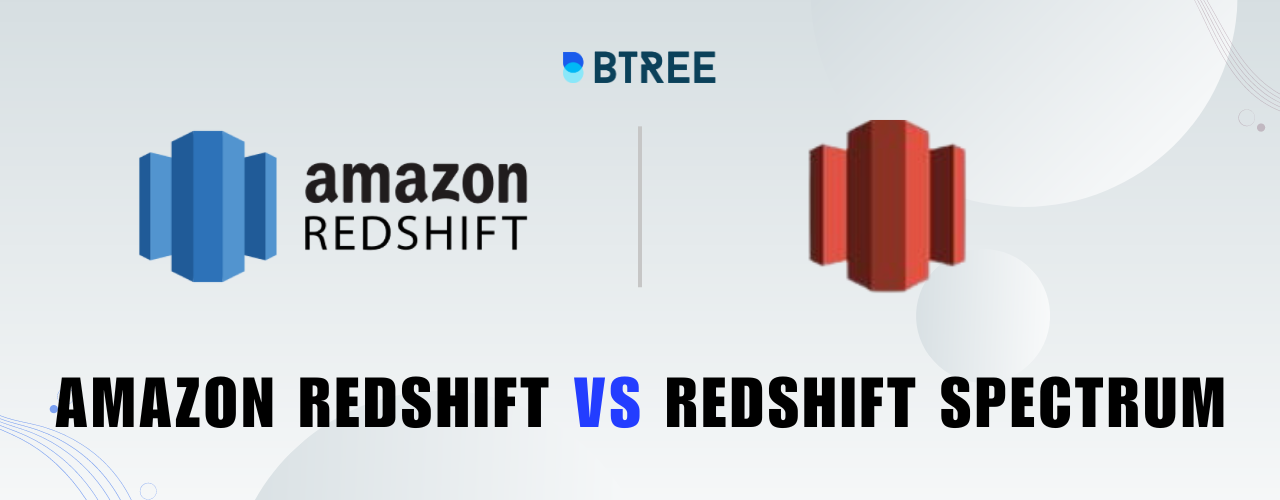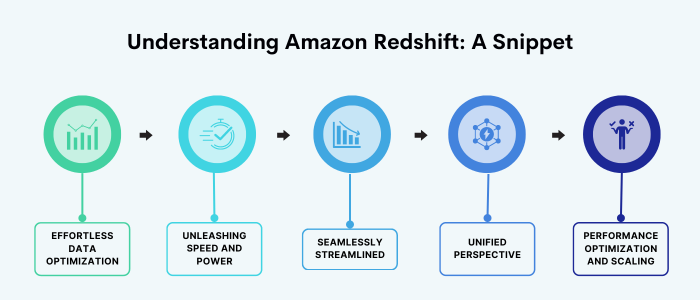
Understanding Amazon Redshift

Amazon Redshift stands as a stalwart data warehousing solution tailored to meet the complex demands of modern enterprises. Its key features and benefits are a testament to its prowess:
A. Effortless Data Optimization
Its innovative approach to data storage is at the core of Amazon Redshift's efficiency. Instead of the traditional row-based storage, Redshift employs a columnar storage format. This design choice has many advantages, such as increased query performance and storage space optimization.
When data is stored in columns rather than rows, it allows for better compression. Similar types of data are stored together, facilitating efficient compression algorithms. This compression significantly reduces the required storage space, leading to cost savings. Moreover, the columnar format enhances data retrieval speed, as only the columns relevant to a particular query are accessed, minimizing I/O operations.
B. Unleashing Speed and Power
Amazon Redshift's Massively Parallel Processing architecture is a marvel in itself. It transforms data processing by distributing queries across multiple nodes, enabling parallel execution. This approach magnifies processing power, leading to lightning-fast query performance even when dealing with extensive datasets.
In essence, MPP divides the workload into smaller, manageable tasks executed simultaneously across the nodes. This parallel processing capability ensures that complex queries and analytical tasks are completed in a fraction of the time it would take with traditional, single-node databases.
C. Seamlessly Streamlined
Data is the lifeblood of modern organizations, and Amazon Redshift recognizes this fact by providing robust data ingestion and transformation capabilities. It integrates seamlessly with various data sources, simplifying bringing diverse data sets into the Redshift environment.
Through integrations with popular data sources like Amazon S3, Amazon DynamoDB, and more, Redshift eliminates the hurdles associated with data movement. It allows for efficient ETL (Extract, Transform, Load) processes, enabling you to transform raw data into a format conducive to analysis and reporting. This integration prowess fosters a unified data ecosystem where data from disparate sources can be harmoniously processed and analyzed.
D. Unified Perspective
In the modern data landscape, integration is paramount. Amazon Redshift excels by providing seamless connectivity with many data sources. Whether your data resides within your on-premises databases, cloud-based systems, or third-party platforms, Redshift's versatile integration capabilities ensure you can bring all your data into a centralized hub.
With direct integrations with Amazon S3, Amazon RDS, and even streaming data from Amazon Kinesis, Redshift provides a holistic perspective of your data, enabling comprehensive analytics and insights. This unified view empowers organizations to make informed decisions based on a comprehensive understanding of their data landscape.
E. Performance Optimization and Scaling
One of the defining characteristics of Amazon Redshift is its flexibility to adapt to varying data workloads. As your business grows and data volumes surge, Redshift scales horizontally to accommodate these demands. This scaling is facilitated by adding more compute nodes, ensuring that the system can handle increased workloads without compromising performance.
Additionally, Redshift provides features such as automatic query optimization and workload management, which fine-tune the performance of your queries. These features analyze query execution plans and allocate resources optimally, resulting in consistently high query performance.
An Overview of Redshift Spectrum
In the ever-evolving landscape of data analytics, innovation knows no bounds. Amazon Redshift Spectrum emerges as a testament to this, extending the capabilities of Amazon Redshift to new horizons. This section delves into the intricacies of Redshift Spectrum, highlighting its seamless integration with Amazon S3 and the remarkable advantages it offers.
A. Decoding Redshift Spectrum's Essence
Redshift Spectrum represents a paradigm shift in how data is queried and processed. It introduces the concept of separation of storage and computing, a concept that redefines data analytics efficiency. Redshift Spectrum allows you to run complex queries directly on data stored in Amazon S3 without loading the data into the Redshift cluster.
By leveraging this architecture, Redshift Spectrum provides a compelling solution for querying vast datasets that might be too large to fit within the confines of a traditional Redshift cluster.
B. Amazon S3 Integration
Redshift Spectrum's strength is amplified by its seamless integration with Amazon S3, the cloud storage service that has become a cornerstone of modern data management strategies. Amazon S3 is renowned for its durability, scalability, and cost-effectiveness, making it an ideal repository for vast volumes of data.
The integration between Redshift Spectrum and Amazon S3 is symbiotic. Redshift Spectrum doesn't physically move data from S3 for processing; instead, it leverages the data's existing location. This reduces data movement overhead and contributes to cost savings, as data is stored efficiently in its native format on S3.
Redshift Spectrum's Advantages
1. Separation of Storage and Compute
At the heart of Redshift Spectrum's prowess lies its unique approach to separate storage and computing. Traditional data warehousing solutions often necessitate duplicating data within the cluster, leading to storage redundancy and increased costs. On the other hand, Redshift Spectrum operates on the principle of querying data in place.
2. Cost-Effectiveness and Scalability
Redshift Spectrum introduces a pay-per-query pricing model that caters to varying workloads. Unlike the traditional Redshift model, where you pay for the capacity of the entire cluster, Redshift Spectrum charges you based on the amount of data scanned during queries. This makes it an economical choice for sporadic, ad-hoc, and exploratory queries.
3. Enhanced Query Capabilities
Redshift Spectrum is tailor-made for querying massive datasets that extend beyond the capacity of a traditional Redshift cluster. Its ability to directly access data in Amazon S3, coupled with the power of parallel processing, means that even the most complex queries can be executed efficiently.
This advantage is particularly significant when dealing with historical or infrequently accessed data. Rather than loading and maintaining this data within the Redshift cluster, Redshift Spectrum enables on-demand access without requiring extensive data movement.
Top 15 Differences Between Redshift & Redshift Spectrum
While Amazon Redshift vs Redshift Spectrum share a common foundation, they diverge in significant ways that cater to distinct analytical requirements. Let's uncover these disparities to empower you in making an informed choice that aligns with your business objectives:
| Features | Amazon Redshift | Amazon Redshift Spectrum |
|---|---|---|
| Data Storage | It stores data within its own. clusters using a columnar storage format, optimizing query performance for complex analytical queries |
Instead of storing data directly in the cluster, it leverages Amazon S3 for storage. This lets you access and query data without moving it into Redshift first. |
| Data Processing: | All data processing, including querying and transformations, occurs within the Redshift cluster. |
It pushes a significant portion of the query processing to the Amazon Redshift Spectrum layer, which runs directly on Amazon S3. This offloads some processing from the cluster. |
| Query Performance: | Amazon Redshift: Optimized for running complex analytical queries involving aggregations, joins, and data transformations due to its dedicated cluster setup. |
Designed more for ad-hoc querying and scanning large datasets without loading them into a Redshift cluster. Performance might be slightly lower for complex queries compared to Redshift. |
| Data Partitioning: | Uses distribution keys to divide data across nodes in the cluster, improving query efficiency by minimizing data movement. |
Utilizes the native partitioning within Amazon S3, which can be helpful for query optimization, particularly for columnar storage formats like Parquet and ORC. |
| Cost: | This tends to be more expensive due to the cost of provisioning and maintaining the Redshift cluster. |
Generally more cost-effective, as you pay for the data scanned during queries rather than maintaining a dedicated cluster. |
| Data Loading: | Supports bulk data loading from various sources directly into the cluster. |
Instead of loading data, you query data already stored in Amazon S3, simplifying the data-loading process. |
| Data Updates: | Supports updates and inserts, allowing modifications to the data within the Redshift cluster. |
Generally read-only access to the data stored in Amazon S3. Updates might require processes to reprocess and reload data. |
| Concurrency: | Concurrency is limited by the cluster size and the number of nodes, affecting the number of simultaneous queries that can be handled. |
Designed to handle high levels of concurrency, as queries are offloaded to the Amazon S3-based Spectrum layer, which can scale more flexibly. |
| Cluster Setup Time: | Requires time for provisioning, setting up, and scaling the Redshift cluster. |
Query processing can start almost instantly, as there's no need to provision a cluster. |
| Metadata Storage: | Stores metadata about tables, schemas, and more within the Redshift cluster. |
Manages metadata in the AWS Glue Catalog, providing centralised cataloguing for data stored in Amazon S3. |
| Backup and Restore: | Requires backups to be taken for the Redshift cluster to ensure data recovery in case of failure. |
Since the data remains in Amazon S3, backups are not explicitly needed for Spectrum. Data durability and recovery rely on S3's capabilities. |
| Query Optimization: | Optimizations are performed mainly within the local Redshift cluster. |
Some optimizations are pushed to the Spectrum layer, which handles query processing on Amazon S3 data, potentially improving query performance. |
| Storage Efficiency: | Stores data in a columnar format within the cluster, which optimizes storage for analytical queries but might lead to some storage redundancy. |
Data is stored in native file formats (e.g., Parquet, ORC) in Amazon S3, providing higher storage efficiency due to compression and columnar storage techniques. |
| Elasticity and Scaling: | Scaling requires resizing the Redshift cluster, which might lead to temporary downtime during the scaling process. |
Offers more elasticity, as query processing is offloaded to the Spectrum layer, which can scale more flexibly based on query demands without requiring manual cluster resizing. |
| Use Cases: | Best suited for OLAP (Online Analytical Processing) scenarios that involve complex queries on structured data. |
Amazon Redshift Spectrum: Ideal for cost-effective querying of large datasets without loading them into a Redshift cluster, which is suitable for data exploration and analysis. |
Our Lovely Student feedback
What to Choose, Amazon Redshift or Redshift Spectrum?
Remember, each solution brings unique strengths, and understanding your data landscape is key to making an informed decision. Let's delve into the crucial aspects that should shape your choice:
A. Data Volume and Scale
The sheer volume of data you handle is a pivotal factor. Amazon Redshift's MPP architecture could offer a significant performance advantage if your data repository is extensive and rapidly growing. The parallel processing capabilities ensure timely query execution even when dealing with vast datasets.
Redshift Spectrum, on the other hand, excels when dealing with historical data that is rarely accessed. Its separation of storage and computing enables efficient querying of extensive archives without duplicating data.
B. Query Complexity and Frequency
Consider the complexity and frequency of your queries. For intricate, real-time queries that demand low-latency responses, Amazon Redshift's MPP architecture is unbeatable.
Conversely, Redshift Spectrum's pay-per-query model makes it a cost-effective choice for sporadic, exploratory, or ad-hoc queries. If your analysis involves frequent queries that demand fast results, Redshift's performance advantage might be the deciding factor.
C. Budget and Cost Considerations
Amazon Redshift's fixed cluster-based pricing provides predictability but might not be the most cost-effective option for varying workloads.
Redshift Spectrum's pay-per-query model offers greater flexibility for scenarios with fluctuating query volumes. You can optimize costs while maintaining analytical capabilities by paying only for the queries executed.
D. Integration with Existing Ecosystem
Evaluate your existing data ecosystem and integration requirements. Amazon Redshift's seamless integration with various data sources might tip the scales if you need to consolidate data from various platforms.
On the other hand, Redshift Spectrum's integration could simplify your data management strategy if your data is already stored in Amazon S3 or if you're looking to optimize data lake storage.
E. Performance Requirements and Latency
The urgency of your insights is a vital consideration. Amazon Redshift's MPP architecture ensures minimal query latency for scenarios demanding rapid response times, making it suitable for real-time analytics.
However, Redshift Spectrum's scalable query capabilities might outweigh this limitation if the slight latency introduced by querying data directly from Amazon S3 isn't a critical concern.
Future Scope of Amazon Redshift and Redshift Spectrum
Amazon Redshift is a powerful tool for handling the growing complexities of data analytics. As data continues to explode in volume, Redshift is a robust solution ready to manage today's data challenges and scale for the even larger data landscapes of the future.
Think of Amazon Redshift as a flexible platform that can adapt seamlessly to changing data demands. Its processing architecture is designed to effortlessly handle large datasets, making it a dependable resource for businesses. Amazon Redshift will likely integrate new technologies as data analytics techniques advance, ensuring it remains a fast and efficient solution for deriving insights from expanding data sources.
On the other hand, Redshift Spectrum complements this by enabling efficient exploration of historical data. As data formats evolve and storage systems improve, Redshift Spectrum is expected to enhance its ability to query diverse data formats more efficiently. With ongoing advancements in cloud computing, Redshift Spectrum will play a crucial role in data exploration strategies.
Regarding career opportunities, the evolution of Amazon Redshift and Redshift Spectrum presents a positive outlook. Professionals utilizing these tools will likely find themselves in high demand in data analytics. Potential career paths include:
- Data Engineers
- Data Analysts and Scientists
- Cloud Architects
- Business Intelligence Specialists
- Data Governance, and Compliance Professionals
Final Thoughts
To wrap it up, remember that Amazon Redshift vs Redshift spectrum offers distinct advantages that cater to specific data needs, strategically aligning the decision with your business objectives.
Amazon Redshift is a stalwart for real-time analytics, seamless integration, and performance optimization. It thrives in scenarios demanding swift insights and intricate data transformations. On the other hand, Redshift Spectrum shines as a beacon of cost-effective querying for historical and large-scale datasets, making it invaluable for data exploration and optimization.
As you traverse this decision-making journey with knowledge about these solutions, remember that your choice isn't just about tools; it's about empowering your organization with insights that drive innovation and propel growth.
Amazon Redshift Course Schedule
| Name | Batches | Details |
|---|---|---|
| Amazon Redshift Training |
Weekend Batch
(Sat-Sun) |
View Details |
| AWS Training |
Weekday Batch
(Mon-Fri) |
View Details |
| Google Cloud Platform Training |
Weekend Batch
(Sat-Sun) |
View Details |
Looking For 100% Salary Hike?
Speak to our course Advisor Now !









